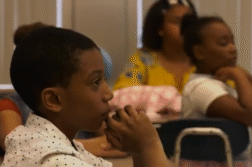GAINESVILLE, Fla. (Ivanhoe Newswire) — June 16th is World Sea Turtle Day. These amazing creatures have been swimming in our oceans for over 100 million years! But six of the world’s seven sea turtle species are currently threatened. They face dangers like plastic pollution and habitat loss, their long migrations and vital roles in marine ecosystems offer clear lessons about our impact on the planet. Sea turtles provide a powerful way to teach children about conservation and the urgent need to protect our oceans for future generations. The tough challenges sea turtles face and their journey can help kids connect with the importance of environmental awareness.
On this day, two rescued and rehabbed green sea turtles are getting a second chance.
“Who doesn’t love sea turtles? Right?” asked Mariela Pajuelo, PhD, assistant scientist at Thompson Earth Systems Institute & Florida Museum of Natural History.
For over 15 years, Pajuelo has studied these animals.
“The biggest threat worldwide is fisheries. They get tangled in the nets or in the fishing hooks or lines,” she told Ivanhoe.
Sea turtle numbers dropped dangerously low in the 80’s and 90’s. Meanwhile today, warmer temperatures are leaving their mark on nesting beaches.
“The majority of the babies that are hatching on the beaches are all females. The sex of the animal depends on the temperature in which the egg is incubated. And so, if the temperature is high, then you’re going to have a higher proportion of female baby sea turtles,” Pajuelo explained.
But there’s good news! Through conservation and education — more baby sea turtles are hatching now! Pajuelo believes learning about sea turtles is a compelling way to demonstrate that individual actions truly matter. What can parents and their children do? Join a beach cleanup to pick up trash that can hurt sea turtles. Use fewer plastic bags and bottles. No matter where you live, plastic travels. Read books and watch shows about sea turtles. Visit nature centers to see turtles close up. Most importantly, be kind to the ocean: never litter, always respect marine life and remember:
“It’s just getting them out there. I would say constantly,” Pajuelo said.
U.S. sea turtle populations are improving, with record Florida nesting due to conservation. Further efforts are still needed. One way to engage your child is by tracking a real sea turtle’s journey for $17 at https://myfahlo.com/.
Contributors to this news report include: Marsha Lewis, Executive Producer; Matt Goldschmidt, Videographer; and Bob Walko, Editor.
Produced by Child Trends News Service in partnership with Ivanhoe Broadcast News and funded by a grant from the National Science Foundation (NSF).
To receive a free weekly e-mail on positive parenting from Ivanhoe, sign up at: http://www.ivanhoe.com/ftk
If this story or any other Ivanhoe story has impacted your life or prompted you or someone you know to seek or change treatments, please let us know by contacting Marjorie Bekaert Thomas at mthomas@ivanhoe.com



